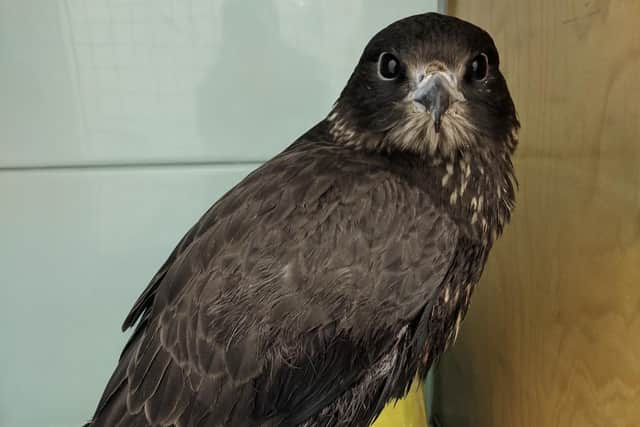Firefighters rescue Harris Hawk from a rooftop in Harborough


The bird of prey was brought down from the house in Nithsdale Avenue, off Northampton Road, after getting stuck on the aerial.
Firefighters from Harborough fire station attended after a passer-by spotted the distressed bird and raised the alarm at 1.37pm.
Advertisement
Hide AdAdvertisement
Hide AdBut they had to call in a specialist aerial ladder platform from Birstall to reach the huge falcon – thought to be stranded 30-40 feet off the ground.


The tricky operation took the six-strong fire crew about 75 minutes as the raptor was finally recovered at 2.52pm, Leicestershire Fire and Rescue Service said.
The injured dark brown hawk was taken to nearby Ash Tree Vets in Northampton Road.
Nurse Mel Saunders, who’s been looking after the creature at the vets, told the Harborough Mail: “It’s certainly caused quite a stir here!
Advertisement
Hide AdAdvertisement
Hide Ad“I’ve worked here 10 years and we’ve never had a Harris hawk brought in before.”
She said they’ve put the fully-grown adult bird in a little kennel.
“We’re trying to keep it calm and chilled out so it doesn’t die.
“It’s suffered a cut on its leg which we’ve assessed but it’s bright and chirpy and should be all right,” said Mel.
Advertisement
Hide AdAdvertisement
Hide Ad“It’s carrying a ring – similar to a dog’s microchip – and that might have snagged on the aerial, trapping it.
“The firefighters did a great job rescuing this beautiful bird and we’re happy to care for it.”
She said they had alerted the Independent Bird Register in a bid to track down the hawk’s owner.
“They should be able to do that from the ring.
“If not we’ve arranged for a local falconer to come in and collect it and make sure it’s OK,” said Mel.
Advertisement
Hide AdAdvertisement
Hide AdThe Harris hawk is a medium-large bird of prey that breeds from the south-west United States south to Chile, Argentina and Brazil.
Regularly used in falconry and with a wingspan of up to four feet, the striking bird of prey is unusual in that it often hunts in packs whereas other raptors almost always hunt alone.